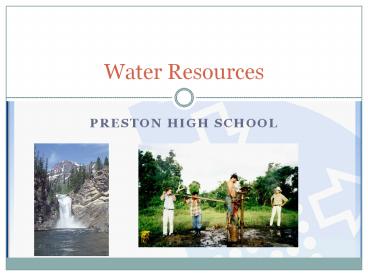Preston High School - PowerPoint PPT Presentation
Title:
Preston High School
Description:
Water Resources PRESTON HIGH SCHOOL Introduction Water Resources Case Study: Walkerton Crisis Conclusions Water Cycle Why Study the Water Cycle? – PowerPoint PPT presentation
Number of Views:173
Avg rating:3.0/5.0
Title: Preston High School
1
Water Resources
- Preston High School
2
Objectives
- Introduction
- Water Resources
- Case Study Walkerton Crisis
- Conclusions
3
Water Cycle
4
Why Study the Water Cycle?
5
What is Hydrogeology?
- Study of the part of hydrology that deals with
the occurrence, movement, and the quality of
water beneath the Earths surface
All streams run to the sea but the sea is not
full to the place where the streams flow, there
they flow again
Ecclesiastes 17
6
What is groundwater?
- Groundwater a major link in the hydrologic
cycle - Found underground in the spaces between particles
of rock and soil, or in the crevices and cracks
in rock Aquifers - Always on the move!
- Over 6 million Canadians rely on groundwater
- Use of groundwater varies by Province
7
Groundwater Consumption
Percentage of population reliant on groundwater
Canada 26
Yukon 63
Northwest Territories 1
British Columbia 22
Alberta 27
Saskatchewan 45
Manitoba 24
Ontario 24
Quebec 22
New Brunswick 64
Nova Scotia 50
Prince Edward Island 100
Newfoundland 29
Agriculture
Industry
Municipalities
8
Groundwater Quality
- Naturally contains various constituents
- Chemical nature of water continually evolves
through the hydrologic cycle - Matter of taste, odour and clarity popularity
of bottled water! - For other uses different properties may be more
important - Industry ? water must not be corrosive, types of
suspended solids
9
Capture Zone
10
Aquifers
11
(No Transcript)
12
Saline Intrusion
13
(No Transcript)
14
Quest for Groundwater!
- Exploration Stage Search for a suitable aquifer
- Evaluation Design analysis of groundwater
wells, use of groundwater modeling - Exploitation Optimal development
15
Point and Non-Point Pollution
- A point source is a single, identifiable source
of pollution, such as a pipe or a drain.
Industrial wastes are commonly discharged to
rivers and the sea in this way. - Non-point sources of pollution are often termed
diffuse pollution and refer to those inputs and
impacts which occur over a wide area and are not
easily attributed to a single source. They are
often associated with particular land uses, as
opposed to individual point source discharges.
16
Point and Non-Point Pollution
17
Groundwater Contamination
Point sources
On-site septic systems
Leaky tanks/pipelines
Municipal landfills
Leaky sewer lines
Graveyards
Road salt from roads
Livestock waste
Non-point sources
Fertilizers on agricultural lands
Pesticides
Contaminants in rain, snow, and dry atmospheric
18
Urban Non Point Sources of Pollution
19
Point Source
20
Non-Point Source
21
(No Transcript)
22
How does the water get to my faucet?
23
Case Study Walkerton Water Crisis
24
Walkerton Crisis
- E. coli outbreak occurred in May 2000
- 7 people died and 100s ill
- Cause contamination of a well not adequately
chlorinated, from manure runoff from nearby
commercial cattle farms - Human error resulted in lost lives, lost health,
lost productivity, and loss of public trust - Ontario Ministry of the Environment has embarked
on a series of legislative initiatives to safe
drinking water
25
Conclusions
- Justice OConnors Report on the Walkerton
Inquiry (http//www.attorneygeneral.jus.gov.on.ca
/english/about/pubs/walkerton/) - Need to invest in state of the art water delivery
system - Push for Source Water Protection in all the
Conservation Authorities in Ontario - Improved, more sensitive tools and methods to
monitor microbial risks to surface and
groundwater - Measures to detect, treat, and respond to
multiple contaminants - All levels of government should coordinate action
plans to fully protect water sources
26
Water Legislation
- Environmental Protection Act
- Environmental Bill of Rights Act
- Ontario Water Resources Act (1990)
- Safe Drinking Water Act (2002)
- Nutrient Management Act (2002)
- Drinking Water Source Protection Act (2004)
27
Overview
- Water Cycle and its interconnection with the
environment - Looked at hydrogeology and how we explore and
exploit our water resources - Discuss the various issues dealing with
groundwater - Concluded with the case study of the Walkerton
tragedy
28
A flood of Pigs- Environmental Science p . 448
- Describe the damage of Hurricane Floyd in 1999.
Provide 3 examples - What is dinoflagellate Pfiesteria? Why is it so
dangerous? - What is Water Pollution? P. 448 -450
- Provide examples of point sources and non
point sources within the text - What is atmospheric deposition? In terms of
finding the sources, why is this difficult? - For further thinking
- Do you think that water pollution is worse now
than it was in the past? What considerations go
into a judgement like this? How do you personal
experiences influence your opinion?































